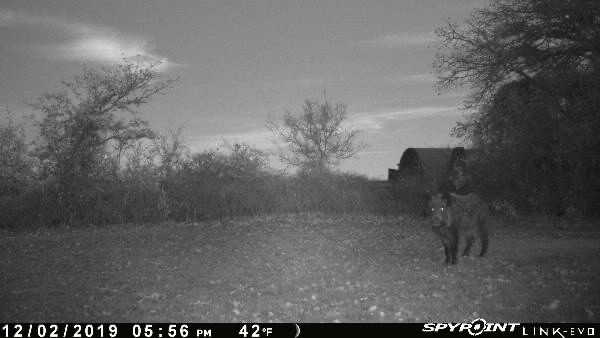THE .357 TRIPLE-OUGHT

By: Kevin Newberry
A couple of articles back I posted a target pic and left you to ponder on how it was accomplished by a single round. This project came from a “what if?” back when I was working on the shotshell snake load for .357 Magnum revolvers.
Back in December when a wild sow decided to terrorize the outskirts of the very small town where my shooting partner resides, we looked at a number of options for her immediate dispatch which occurred the day following our range/test session. Obviously his Savage M10 in .308 WIN was a candidate, and ultimately the tool he used, but closer range options needed to be considered after an encounter of the close kind where she contemplated charging him. We looked at 12 Gauge slugs and buckshot. Among the buckshot loads were some old 000 rounds that looked kind of suspect, so they were not fired. Not wanting to dispose of them, I wondered if I might be able to make use of the 000 pellets. According to spec, 000 pellets are supposed to be .355” in diameter, 9mm, which was enough reason for me to have an interest in salvaging the pellets.

My partner had recently won a raffle for a new S&W 686+ 4” 7-shooter. It has turned out to be a gem, not showing any problems ejecting cases after firing full-power loads as we had observed some years previously, firing a 4” Taurus Tracker he had bought used at a very attractive price. Then we found out by water testing what a great bullet the SPEER 158 gr. JSP is. Handgun Hunters often jump to heavy hard-cast bullets for penetration on game and overlook Jacketed Soft-Points. They don’t expand like a JHP, but some expansion is better than no expansion and they penetrate plenty deep. The Hornady 158 gr. XTP-FP (JSP) is another good example, but at Midway USA the price for the SPEER 158 gr. JSPs was just too good to pass up.
Having just completed the article for the snake loads, I began to mull over the possibilities for revolver loads with those 000 pellets. Putting two pellets in a .38 Special case seemed easy enough, but I wanted three. Another option considered was using a .357 Maximum case and layering 7 ½ shot between the 000 pellets. That may yet happen. Max case length for the .357 MAX is 1.605”, and just over the .357 Magnum’s Max OACL of 1.590” while the dimension from the case-rim to the cylinder face of my Ruger GP100 is 1.661”.

The pic above, and previewed in an earlier article, is from the first test with the target just over 12’ from the muzzle and just over 800 FPS in velocity. The powder charge was 4.5 grains of True Blue.
There was just one problem; the case did not eject cleanly from the GP100 (6-shooter) as it should have. Working on a solution, I developed a suspicion that I had overly packed the powder charge when seating first a cardboard wad and then a plastic wad over it. A number of options were considered, and yesterday, 5/13/20, two alternative loads were test-fired. In the first case I simply avoided over-packing the powder charge. I did the same with the 2nd option, but I added just enough Cream of Wheat over the wads to fill the void under the bottom pellet’s hemisphere while I seated that pellet with the case inverted with an aluminum dowel rod. As far as a tip on how much Cream of Wheat to add, put a pellet into a .38 or .357 case, then add enough C-o-W to cover the pellet to its top. Then with a funnel atop the actual round you’re making, dump the measure of C-o-W down through the funnel and over the wads. You will need to rod that first and bottom pellet just snug to the wad holding the case inverted so that it will fill the void below the pellet.
There will be some trial and error in making these loads. Firstly, don’t be concerned about tightly packing the components into place. As I mentioned in the .357 Mag. Shotshell article, I had to use a cardboard wad over the charge of True Blue in order to prevent it from leaking because it is so fine and dense. The plastic wad was added above it to increase rigidity under the bottom pellet. I found that everything will come together by having the 2nd pellet just deep enough into the case so that the top pellet will rest atop it. Or, you may find that you need to hold the top pellet into position until it enters into the seating die. In the case of the Lyman seating die used, it came with 3 seating stems, one of which is for round nose bullets. I set it to seat the top pellet just deep enough that the case-mouth is just above the middle of the pellet and then applied a roll crimp in a separate step. And as before with the snake shot loads, I reamed and chamfered a case for my “cookie cutter.”

The powder charge (4.5 grs of True Blue) did not change for the alternative loads due to the limited space for the powder charge. In reviewing alternate powders, only Accurate No 5 seemed to be an option. No 5 and True Blue are very similar in burn rate, bulk density and physical size of the grains. If you have No 5 rather than True Blue, the powder charge may need to increase by .1–.2 grains. No 5, technically, is denser, but we’re talking about a very slight difference in bulk density with No 5 being .990 grams/cc vs .975 grams/cc for True Blue while No 5 might burn just barely slower in this application. On that I can’t say definitively because in different cartridges the burn rates of these powders can swap positions. In most cases, however, a very slightly higher charge of No 5 will be required to match the velocity of the True Blue charge. 4.6 grs. Of No 5 is very close to the volume of 4.5 grs. Of True Blue by simple calculation. None of the faster burning Western powders will work within these constraints, and a slower burner like No 7 will result in a significant loss of velocity. My selection of True Blue for this project came once again from my confidence in its pressure stability. So far as I’m aware, there are no other suitable powders for this application, regardless of brand. So now would seem the right time for the advisory: Neither Western Powder Co. nor I will be responsible for the use of this EXPERIMENTAL load or any variation of it.
Can velocity be increased above 800 FPS? That will be for you to decide. My opinion is that it won’t be by much. Provided that you can fit the pieces together with an increase in powder charge. For my own personal use, I may try adding .2 grs. Of True Blue to see if velocity will rise to 850 FPS. I would, however, advise that when fired cases do not properly eject from the cylinder, you have exceeded the practical limit. My goal was to simply provide the basic load.

Does such a load have merit as a defense round? Again, that’s for your discretion. I can say, however, that a 000 buckshot pellet is around 20 grains lighter than the single .36 caliber lead ball that James Butler (Wild Bill) Hickok used to deadly effect at around 850 FPS. And in one particular of his several gunfights it is reported that he shot and killed gunman Davis Tutt at a reported distance of 75 yards across the town square. No doubt about it being very fortuitous shot placement, if in fact, that distance was 75 yards. As we will see from the previous target pic above and those that will follow, there is a significant increase in pattern size as distance increases. For me personally, I would consider it a close-range option and maybe viable to 10 yards Max with 7 yards being more realistic. And because of the 000 pellets I’ve weighed at just over 60 grs., it could greatly reduce the potential of over-penetration within one’s home. All of the following targets were at 7 yards from the muzzle.
In the first target above I fired both the 1st and 2nd test rounds into the same target basically due to the orientation of the target when I fired over the chronograph.
The next target is the 1st round (3rd overall) where I added Cream of Wheat under the bottom pellet. It turned out to produce the largest pattern of 3.1”.

Last but not least, the 4th tester of the day produced the smallest pattern of 2.1” while recording the highest velocity of 800 FPS. Considering the preliminary test round chrono’d 804 FPS, adding the four test rounds chrono’d 5/13/20, the average velocity was 796.4 FPS.

In departing, I’m dedicating this article to Mr. Rob Behr. His service to Western Powder Company has been superlative. Not only from his duties here, but because I’ve seen him demonstrate a strong desire to do the same at other venues. He has always been very complimentary and helpful to me and my writing projects, as well as with some experimental rounds (Wildcats) I have not written about. I am proud to call him a friend and peer of the first order. Not everyone has had the benefit I have in knowing the depth of his knowledge in handloading and all aspects of shooting. May you have a long and happy retirement, buddy! (and please don’t edit out this paragraph!)
And as always, God Bless, be safe and good shooting to you all!
Kevin
